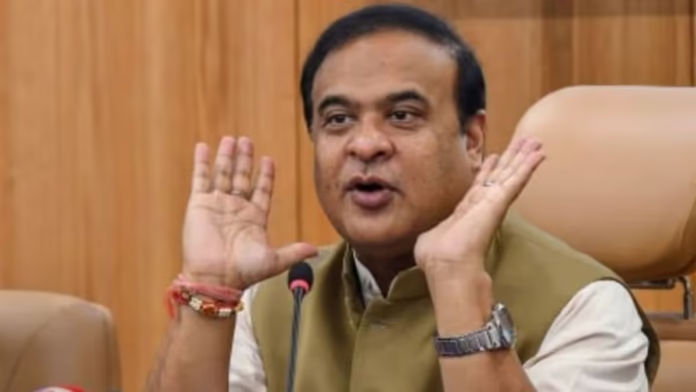Assam Chief Minister Himanta Biswa Sarma has shed light on the historical challenges that have shaped Assam’s trajectory while expressing optimism about its economic revival. Through recent statements and social media posts, Sarma has emphasized the state’s past struggles, including multiple partitions, economic neglect, and landlocked geography. However, he also assured that Assam is witnessing unprecedented economic growth, surpassing states like West Bengal in terms of investment proposals.
Historical Challenges: Partition and Neglect
Speaking on Assam’s tumultuous past, CM Sarma highlighted that the state had undergone five partitions, significantly impacting its political, administrative, and economic stability. In a recent tweet, he stated: “Did you know Assam had serious legacy issues? We bore the brunt of partition, the state was divided five times, and we lost our capital. It was only after 2014 that the Government of India laid special emphasis on bringing Assam to the mainstream.”
This historical fragmentation left Assam in a weakened state, facing administrative challenges and a lack of central government attention for decades. Sarma pointed out that while West Bengal remained intact after the country’s partition, Assam endured repeated divisions that slowed its economic and infrastructural progress.
One of the biggest setbacks Assam faced was losing its capital without receiving any financial assistance to rebuild. Sarma expressed frustration over this issue: “Assam is the only state in India that has been deprived of her own capital. We were asked to leave our capital, and nobody gave us a single rupee to reconstruct our own capital.”
He further noted that militancy, isolation, and years of neglect compounded Assam’s economic struggles, preventing industrial and infrastructural development. According to Sarma, the period between 1947 and 2014 saw little attention given to Assam’s development, which led to a lack of self-reliance and progress.
Assam’s Economic Growth: Surpassing West Bengal in Investment Proposals
Despite these historical setbacks, Assam is now witnessing rapid economic progress, attracting massive investments. CM Sarma claimed that Assam may have surpassed West Bengal in terms of investment proposals received, signaling a major shift in the state’s economic trajectory. “Bengal must have attracted around ₹4.4 lakh crore proposals, but we must have crossed more,” he said, promising to share exact figures at an upcoming press conference.
While Sarma compared Assam’s recent investment growth with Bengal’s, he also acknowledged Bengal’s larger size and influence: “Bengal is a great state, big state, big population. Assam is a small state, so I won’t want to compare with other states.”
This balanced approach reflects Assam’s distinct economic journey, separate from other Indian states, while emphasizing its strong investment potential.
Key Factors Driving Assam’s Economic Revival
Several policy initiatives, infrastructural developments, and improved governance measures have contributed to Assam’s economic resurgence. Some of the major factors include:
1. Post-2014 Developmental Focus
CM Sarma credited post-2014 Central Government policies for helping Assam integrate into India’s mainstream economy. Key developments include:
- Massive infrastructure projects, such as new highways, bridges, and railway expansions
- Industrial development policies aimed at attracting large-scale investments
- Better security and governance, reducing insurgency-related disruptions
- Integration with Southeast Asian markets under the Act East Policy
2. Surge in Investor Confidence
Assam’s improved governance, transparent policies, and proactive business environment have significantly boosted investor confidence. The state has been able to attract major investments in:
- Petroleum and natural gas industries
- Tea and bamboo production
- Tourism, hospitality, and real estate
- Technology and startup ecosystems
3. Strengthening Trade and Commerce
Assam has been actively enhancing its trade and commerce potential through:
- Strengthened Indo-Bangladesh trade ties, boosting cross-border commerce
- Expansion of Guwahati as a regional commercial hub
- Revival of the Brahmaputra River as a key waterway, improving trade routes
4. Focus on Entrepreneurship and MSMEs
The Assam Startup Policy and initiatives like APART (Assam Agribusiness and Rural Transformation Project) have significantly encouraged entrepreneurship. These programs are:
- Providing financial support and incubation for local startups
- Strengthening rural economy through agribusiness
- Encouraging women-led enterprises and self-sustainability
5. Job Creation and Employment Opportunities
With increased investments, Assam is witnessing a rise in job creation across various sectors. The state government has:
- Launched skill development programs to equip youth for emerging industries
- Encouraged public-private partnerships (PPP) for large-scale employment
- Focused on boosting the tourism industry, creating jobs in hospitality, travel, and related sectors
Challenges and the Road Ahead
Despite the economic transformation, Assam still faces some challenges that need to be addressed to ensure long-term sustainable growth:
1. Infrastructure Development
- Assam still requires better road, rail, and air connectivity to attract more industries.
- The state needs smart cities and urban planning to accommodate future investments.
2. Bureaucratic Hurdles
- Reducing red tape and bureaucratic delays is essential for faster investment approvals.
- The government must focus on ease of doing business policies to attract more foreign direct investment (FDI).
3. Inclusive Economic Growth
- Economic progress should reach all sections of society, ensuring rural and urban balance.
- The government must address income disparities and ensure inclusive development policies.
CM Himanta Biswa Sarma’s vision for Assam’s economic revival is deeply rooted in its historical struggles and the need for stronger governance and investment-friendly policies. Despite decades of neglect, Assam is now emerging as a key economic player in Northeast India, with unprecedented investment proposals.
With a clear roadmap for growth, Assam is set to strengthen its industrial base, trade relations, and infrastructure. If the current momentum continues, the state could become a leading economic hub in Eastern India, bridging the gap between the Northeast and global markets.
As CM Sarma continues to drive economic reforms, Assam’s transformation could serve as a model for other states seeking development after historical setbacks. The journey ahead will depend on sustained policy support, strategic partnerships, and inclusive economic planning.




